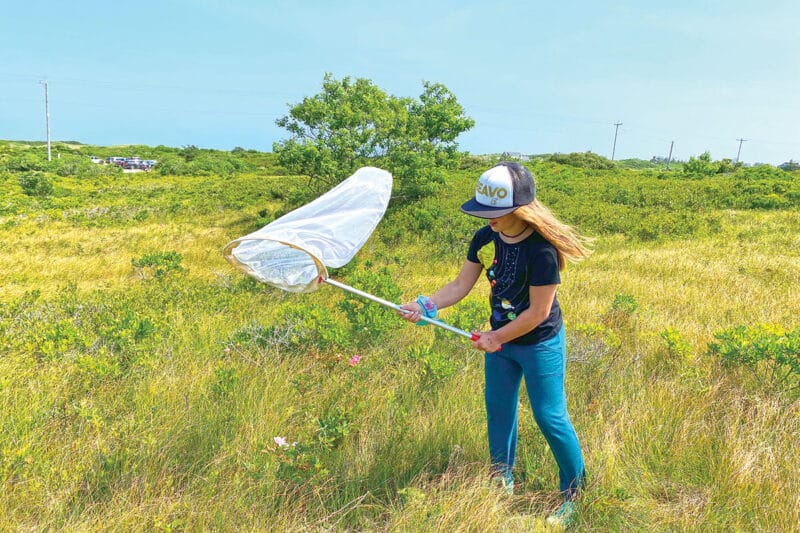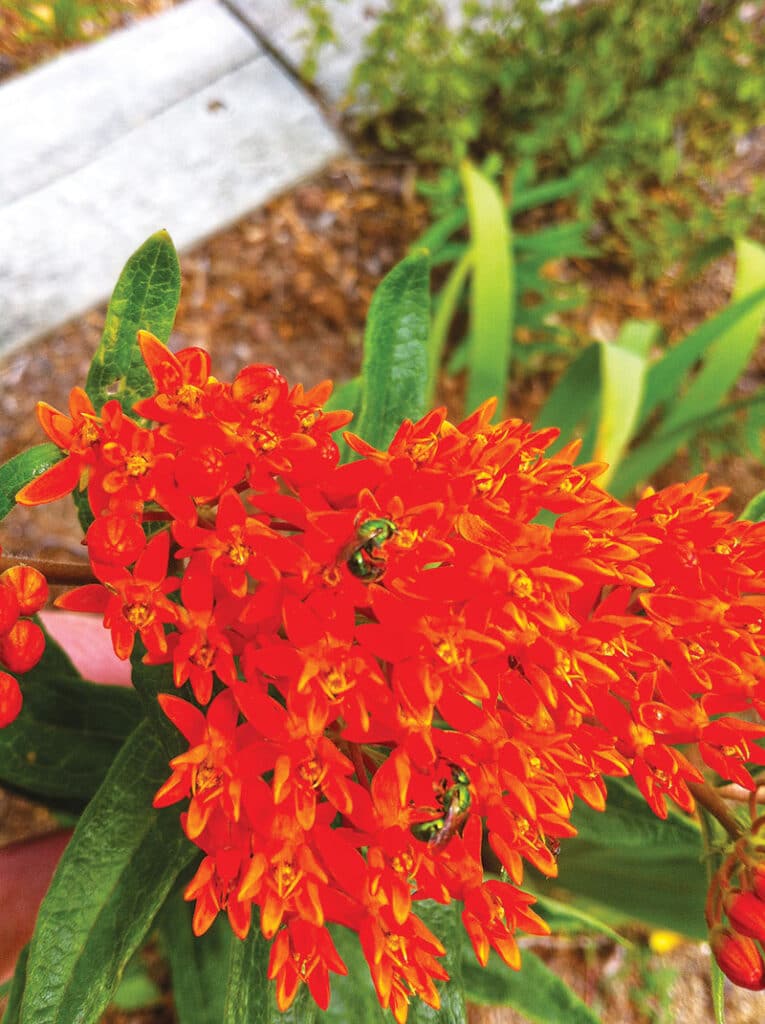by Dr. Sarah Treanor Bois, PhD
Director of Research & Education at the Linda Loring Nature Foundation
We know our little island is special. There are so many unique and wonderful things about Nantucket: the history, the community, our flora and fauna, and our open space protection.
Now we can add one more thing to the list; our bees.
The results are in after a five-year regional project showcasing native pollinators in the northeast. And something special showed up for the Nantucket sites. It turns out, we have some of the highest native bee diversity in the region. Not only that, we learned that Nantucket is home to many specialist bees known as solitary and ground-nesting bees.
So what’s the buzz all about?
Many pollinators depend upon open habitats and canopy gaps for foraging, and recent studies suggest that, in the Northeastern United States, grasslands and barrens support a unique native pollinator assemblage. These habitats require active management, are in decline, and have been identified as priority conservation targets in many states. Nantucket, with its sandplain grasslands and coastal heathlands, has many of these early successional habitats available for native pollinators.
The Xeric Grassland, Barren, and Woodland Pollinator Conservation Project was designed to assess pollinator communities across 20 “nature preserve” sites in the Northeast, including Nantucket, Martha’s Vineyard, and sites in Rhode Island, Maine, Delaware and more. It was funded by a grant awarded through the Northeast Regional Conservation Needs Program. A large network of ecologists, entomologists, and other professional staff sampled the environment, plants, bees, and moths in these sites across seven northeastern ecoregions from Maryland and Delaware to northern New England and Upstate New York. The goal of the project was to understand how and why pollinator communities vary across xeric habitats in the Northeast and to assess the utility of management treatments for enhancing pollinator communities. Xeric habitats are characterized by exceptionally dry, well-drained and nutrient-poor soils compared to other habitats. Our sandy island soils perfectly meet the definition of “xeric” conditions.
On Nantucket, both the Linda Loring Nature Foundation (LLNF) and the Nantucket Conservation Foundation (NCF) participated in the project by establishing transects on some of their properties and collecting vegetation and insect data for the past five years. The sandplain grasslands and heathlands are a perfect study area for this project. Many pollinator species depend on the open habitats, bare soils, and canopy gaps characteristic of these habitats.
A myriad of threats pose significant risk to these habitats, including habitat fragmentation, losses associated with accelerated habitat succession, and the effects of fire suppression. Due to the rare species xeric sites support, management of these niche habitats has become a considerable focus. Another goal of the The Xeric Pollinator Conservation Project was to determine best management practices to restore or maintain habitat quality for native pollinators.
Starting in 2018, insect pollinators were sampled via a “bee cup” and netting methods monthly from May to September. Collected insects (with a target of bees and flies) were then sent to the USGS Native Bee Inventory and Monitoring Lab at the Patuxent Wildlife Research Center in Laurel, Maryland for identification. Sites also collected phenological info about what were the primary plants blooming in each season to understand more about what flowers were available to the pollinators throughout the season. The number of individuals sampled and species documented in the entire study was considerable. For plants, 279 species were documented across 164 transects. For bees, 19,869 individuals representing 262 species were collected and identified via pan-trapping in 20 preserves.
In terms of overall numbers, Nantucket, represented by LLNF and Head of the Plains (NCF), had some of the highest bee abundance. However, the greatest abundance and species richness goes to the Sandbar Wildlife Management Area in Vermont and the Albany Pine Bush Preserve in New York.
In particular, solitary and soil nesting bees were present in significantly higher abundances than other bee types, which were most prevalent at grassland sites including Linda Loring and Head of the Plains (HOP). LLNF and HOP also hosted some rare bee populations (species with fewer than 50 observations).
At the Linda Loring Nature Foundation, one unique bee, found only at that site was Lasioglossum marinum. It is a member of the sweat bee family and a sand dune specialist only found on the coast of the eastern United States.
What’s so special about ground nesting and solitary bees?
When many people think of bees, it is honeybees and bumble bees that come to mind. These are both very social species living in colonies, as many of us know. However, there are also many bee species which are considered solitary bees. These include carpenter bees or sweat bees which nest in the ground or wood. Mining bees dig burrows in sandy or dirt paths and other places with sparce vegetation. These native bees are important pollinators for our suite of native plants. In fact, native bees are more efficient at pollination than non-native honeybees.
Globally, 70% of wild bees nest below ground and require protection during this crucial period of their lifecycle. Recent research has demonstrated the extent of threats to which ground-nesting pollinators are exposed, for example, chemicals and deep tillage. Ground-nesting pollinators change soil texture directly by digging cavities. In 2022, the Convention on Biological Diversity stated that we should be protecting ground-nesting pollinators explicitly within soil biodiversity conservation.
A major focus of the Xeric Habitats Conservation Project was to identify ways to promote improving habitat for native pollinators. In the study, management treatments were shown to enhance potential bee habitat by decreasing woody cover and showed an increase in early successional flowering plant cover, as well as bee and moth host plant cover, providing a long-term benefit to both.
A primary take-away for our nutrient-poor, sandy soils on Nantucket is to maintain open canopy and exposed soil areas to provide nesting habitat. Managing for the exposure of bare soil is something restoration sites should design for and anticipate as a site maintenance objective. Maintenance activities that encourage the proliferation of bunch grasses or other naturally-sparse vegetation which preserves access to the soil, should facilitate pollinator species richness and abundance.
The results of this study will be incorporated into future management plans for our area. The full report is being finalized by the Northeast Fish and Wildlife Diversity Technical Committee of the Northeast Association of Fish and Wildlife Agencies. For now, best management practices can be found at northeastbarrens. org. The report will be available soon with a link posted on the Linda Loring Nature Foundation website: llnf.org.
What can you do to help native pollinators? Start in your own yard!
Plant native species! Lay off the pesticides. Most sprays are non-specific, so if you try and kill one thing, you could actually be killing all the bees and butterflies as well. Provide a diversity of pollinator-friendly plants with various bloom times ensuring availability throughout the growing season. Don’t clean up every area of your garden. Fallen plant material and twigs can provide important habitat and breeding areas. Please leave at least a small portion of your yard with some debris. And, finally, support your local conservation organization! These groups, like LLNF and NCF, do a lot to support native pollinators and manage important habitat.






